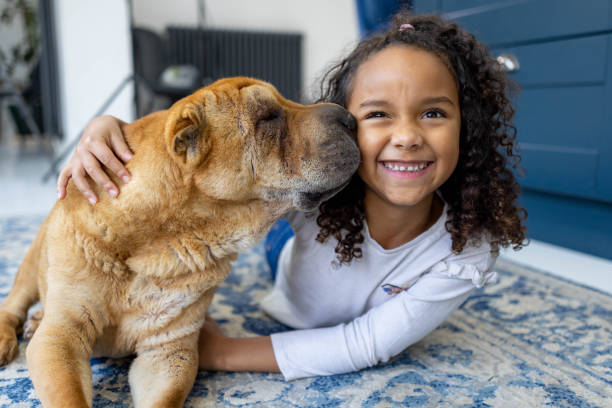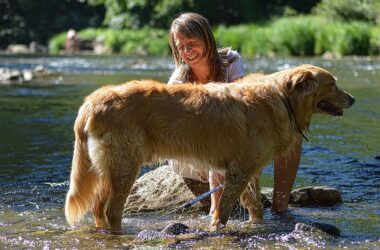Welcome to “Pet-Proofing Your Home: Essential Tips for a Safe Environment.” As pet owners, our homes are not just places of shelter; they are the havens where our beloved four-legged companions play, rest, and explore. Our pets bring immeasurable joy and companionship into our lives, and it is our responsibility to ensure that they live in an environment that is not only comfortable but also safe.
This comprehensive guide is your roadmap to creating a secure haven for your pets, filled with insights, practical advice, and essential tips to safeguard their well-being within your home. Whether you have a playful puppy, a curious kitten, a rambunctious rabbit, or any other animal companion, this guide is designed to empower you with the knowledge and tools necessary to pet-proof your living space effectively.
Throughout the following pages, we will embark on a journey through the various aspects of pet-proofing, from protecting them against common household hazards to creating enriching and comfortable spaces that cater to their needs. We will explore how to prevent accidents, minimize stress, and enhance the overall quality of life for your pets, all within the confines of your home.

Pet-proofing is not just about avoiding potential dangers; it is also about fostering an environment that promotes the physical, mental, and emotional well-being of your pets. Whether you are a first-time pet owner or a seasoned guardian of multiple furry friends, this guide will provide you with valuable insights and practical strategies to transform your home into a sanctuary where your pets can thrive.
So, let’s begin our journey into the world of pet-proofing, where safety and comfort go hand in paw. By implementing the tips and advice within these pages, you will not only protect your pets from harm but also strengthen the bond you share with them, creating a harmonious and secure living space where both you and your animal companions can enjoy the joys of coexistence to the fullest.
Understanding Your Pet’s Needs and Behaviors
Understanding your pet’s needs and behaviors is at the core of responsible and harmonious pet ownership. Pets, whether dogs, cats, birds, or other animals, have unique requirements, instincts, and communication methods that differ from our own. To provide the best care possible, it is essential to delve into the intricacies of their nature and understand what drives their actions.
One crucial aspect of understanding your pet’s needs is recognizing their physical requirements. These include nutrition, exercise, grooming, and medical care. Each species and individual pet has specific dietary needs, activity levels, and health considerations. By closely observing their habits and consulting with a veterinarian or avian specialist, you can tailor their diet, exercise routine, and healthcare regimen to ensure they thrive.
Understanding your pet’s mental and emotional needs is equally vital. Many pets, especially dogs and cats, require mental stimulation, social interaction, and a sense of security. Boredom and loneliness can lead to destructive behavior, anxiety, or depression. By providing enrichment activities, companionship, and a safe environment, you can cater to their emotional well-being.
Pets also communicate their needs and emotions through behavior. Learning to interpret your pet’s body language, vocalizations, and actions is key to responding appropriately. For example, a dog’s wagging tail can signify happiness, while a cat’s purring may indicate contentment or stress. Understanding these cues allows you to address their needs, whether it’s providing comfort, playtime, or a quiet space.

Moreover, it’s essential to consider your pet’s species-specific behaviors. Cats, for instance, are natural hunters and climbers, while birds have a strong desire for social interaction and mental stimulation. Recognizing and accommodating these instincts helps create a living environment where your pet can engage in natural behaviors, reducing stress and promoting overall well-being.
By understanding your pet’s needs and behaviors, you can establish a strong and mutually fulfilling bond. The more in tune you are with your pet’s physical and emotional requirements, the better equipped you will be to provide a safe, nurturing, and enriching environment. Ultimately, this knowledge fosters a harmonious relationship based on trust, affection, and the fulfillment of your pet’s unique needs, resulting in a happy and contented companion.
Creating a Safe and Comfortable Environment
Creating a safe and comfortable environment for your pet is paramount to their well-being and happiness. Our homes, while cozy for us, can pose various hazards to our animal companions. Therefore, it’s essential to take proactive steps to ensure their safety while also optimizing their living space for comfort and enrichment.
Understanding Pet Nutrition: A Comprehensive Guide to Feeding Your Furry Friend
Safety is the first consideration when pet-proofing your home. This involves identifying potential hazards such as toxic plants, chemicals, electrical cords, sharp objects, or choking hazards. Securing these items or keeping them out of reach can prevent accidents and injuries. Additionally, consider the safety of outdoor spaces if you have a pet that enjoys time in the yard. Ensure that fences are secure, and gates are locked to prevent escape, and be mindful of potential dangers like toxic plants or sharp objects.
Comfort is equally vital for your pet’s well-being. Provide them with a designated space that includes a comfortable bed or shelter, access to fresh water, and a safe retreat where they can relax without disturbances. Pets, especially cats and dogs, value routine and consistency, so establishing a designated area can help them feel secure and reduce stress.
Enrichment is a key component of a comfortable environment. Offer a variety of toys, scratching posts, puzzles, and opportunities for play and exploration. Rotate toys to keep their interest, and consider puzzle feeders or treat-dispensing toys to engage their minds. Regular exercise and interactive playtime with you or other pets are essential to prevent boredom and behavior problems.
Environmental considerations also extend to temperature control. Ensure that your pet is neither too hot nor too cold by providing appropriate shelter and climate control. Keep an eye on extreme weather conditions, and adjust your pet’s living conditions accordingly.
Lastly, create a space that promotes social interaction. If you have multiple pets, ensure they have separate feeding areas and offer individual attention to each pet to prevent conflicts. Establish a routine for meal times, walks, and play sessions, which can provide structure and predictability for your pet.
In conclusion, creating a safe and comfortable environment for your pet involves a combination of safety precautions, comfort provisions, enrichment opportunities, and attention to their physical and emotional needs. By considering your pet’s unique requirements and preferences, you can provide a living space where they not only feel secure and content but also thrive in a happy and fulfilling way.
Preventing Common Accidents and Injuries
Preventing common accidents and injuries is a crucial aspect of responsible pet ownership, as it helps ensure the safety and well-being of our beloved animal companions. Just as we child-proof our homes for the safety of our children, pet-proofing our living spaces is equally essential when sharing our lives with pets.
One common accident to guard against is pet poisoning. Many household items, including certain plants, cleaning products, medications, and even human foods, can be toxic to pets if ingested. Keeping these substances out of reach and using pet-safe alternatives whenever possible is key to preventing accidental poisonings. Familiarizing yourself with common pet toxins and promptly seeking veterinary assistance if you suspect your pet has ingested something harmful can be lifesaving.
Another prevalent source of injuries is falls. Cats, in particular, are known for their climbing and exploring behavior, which can lead to accidents if they access high places or windowsills without proper precautions. Installing safety gates or screens and securing heavy objects that could fall can mitigate these risks. Additionally, ensuring that balcony railings are safe and windows are screened can prevent pets from falling from heights.
Household electrical cords are another potential danger. Pets may chew on cords out of curiosity or teething discomfort, leading to electrical shocks or burns. Using cord covers, deterrent sprays, or keeping cords out of reach can help protect your pets from this hazard. Similarly, small objects that pets might swallow should be picked up and stored safely to prevent choking or intestinal blockages.

To prevent burns or fires, pet owners should be cautious with open flames, hot stovetops, and space heaters. Pets may accidentally knock over candles, step on hot surfaces, or get too close to space heaters, resulting in burns or fires. Supervision, safety measures like using flameless candles, and securing stove knobs can reduce these risks.
Additionally, it’s essential to secure heavy objects and ensure that furniture is stable to prevent pets from being crushed or trapped underneath. Baby-proofing products, such as safety straps and corner protectors, can be adapted for pet-proofing purposes to secure heavy furniture and prevent tipping accidents.
In conclusion, preventing common accidents and injuries in your home requires a combination of awareness, precautions, and responsible pet ownership. By identifying potential hazards, implementing safety measures, and staying vigilant, you can create a safe and secure environment where your pets can thrive without the risk of common accidents and injuries that might otherwise compromise their well-being.
Training Your Pet to Be Safe
Training your pet to be safe is a fundamental responsibility of pet ownership, as it not only safeguards their well-being but also fosters a harmonious living environment for both you and your furry companion. Whether you have a new puppy, kitten, or an older pet, instilling safety-related behaviors and commands is essential for their protection.
One of the first safety behaviors to teach your pet is recall. A reliable recall command, such as “come” or “here,” can be a lifesaver in situations where your pet’s safety is at risk, such as when they are about to run into traffic or approach a potentially dangerous situation. Consistent training and positive reinforcement methods are effective ways to teach this crucial command.
Another vital aspect of safety training is teaching your pet to walk on a leash. This is especially important for dogs but can also apply to some cats and other animals. A leash-trained pet is less likely to dart into traffic or engage in risky behavior during walks. Consistent leash training, using positive reinforcement techniques, can help your pet understand the boundaries and expectations when on a leash.
Teaching your pet to immediately let go of something they’ve picked up or to avoid eating or touching potentially harmful items on command can prevent accidental ingestions or injuries. Consistent practice and rewarding good behavior can reinforce these commands.
Furthermore, crate training can be a valuable safety tool. A well-trained pet should see their crate as a safe and comfortable space. In emergencies or situations where they need to be confined for their safety, they will be more cooperative and less stressed if they are accustomed to their crate.

In the case of cats, teaching them not to scratch or climb certain items can prevent accidents, injuries, and damage to your home. Providing appropriate scratching posts and redirecting their behavior using positive reinforcement can help keep them safe and your furniture intact.
Overall, safety training is an ongoing process that requires patience, consistency, and positive reinforcement. By teaching your pet these essential commands and behaviors, you are not only ensuring their safety but also enhancing your relationship with them. Training creates a sense of trust and cooperation between you and your pet, allowing them to understand and respond to the cues that keep them out of harm’s way and contribute to a safe and happy life together.
Being Prepared for Emergencies
Being prepared for emergencies is a critical aspect of responsible pet ownership, as it can mean the difference between life and death for your beloved animal companions. Emergencies can come in various forms, from natural disasters like hurricanes and wildfires to everyday situations such as accidents, sudden illnesses, or unexpected escapes. Having a well-thought-out plan and necessary supplies in place can help you protect and care for your pets in times of crisis.
One of the first steps in emergency preparedness is creating a pet-specific disaster plan. This includes identifying safe evacuation routes and shelters that accept pets, as not all emergency shelters allow animals. Ensure your pets are microchipped and have visible identification tags with up-to-date contact information in case they get lost. Have copies of important documents, including vaccination records and medical history, readily available in a waterproof container.
An essential component of emergency preparedness is assembling a pet emergency kit. This kit should include a sufficient supply of food, water, medications, and necessary supplies such as bowls, leashes, and carriers. Keep a first-aid kit tailored to your pets’ needs, including items like bandages, antiseptic wipes, and tweezers. Consider your pet’s comfort and well-being by including items like blankets, toys, and familiar bedding to reduce stress during emergencies.
If you have multiple pets, ensure you have adequate supplies for all of them. Keep your emergency kit in a readily accessible location, and regularly check and update its contents to ensure everything remains fresh and functional.
Establish a designated point of contact for family members in case you are separated during an emergency. Ensure that everyone knows how to reach this point of contact and understands their role in coordinating the safe evacuation or care of your pets.
Training your pets to respond to basic commands can also be invaluable during emergencies. Commands like “come,” “stay,” and “quiet” can help keep them safe and under control in unfamiliar or stressful situations. Regular practice of these commands can reinforce their obedience during emergencies.
Lastly, stay informed about potential emergencies in your area by monitoring weather updates and local news. Be prepared to act quickly if necessary and follow evacuation orders promptly. By planning ahead and being prepared for emergencies, you can ensure the safety and well-being of your pets and provide them with the best possible care when it matters most.
conclusion
In conclusion, “Pet-Proofing Your Home: Essential Tips for a Safe Environment” serves as a comprehensive guide to creating a secure and nurturing living space for your cherished animal companions. Throughout this guide, we’ve explored the multifaceted aspects of pet-proofing, from safeguarding against common accidents and injuries to training your pets to be safe and preparedness for emergencies.
By following the tips and advice within these pages, you have taken a proactive step in ensuring the safety, comfort, and well-being of your pets. Pet-proofing is not only about protecting them from potential hazards but also about fostering an environment where they can thrive physically, mentally, and emotionally.
As responsible pet owners, it is our duty to create an atmosphere where our pets can be themselves, explore, play, and relax without undue risk. By identifying and addressing potential dangers, providing proper training, and being prepared for emergencies, you are not only enhancing their quality of life but also strengthening the bond you share with your animal companions.
Remember that pet-proofing is an ongoing process, just as your pet’s needs and behaviors may evolve over time. Stay vigilant, stay informed, and stay connected with your pets. In doing so, you ensure that your home remains a sanctuary where both you and your furry friends can enjoy a safe, harmonious, and fulfilling life together.






